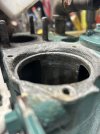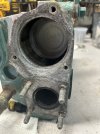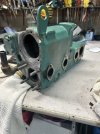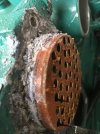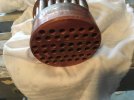Newf
Well-known member
- Joined
- Apr 10, 2014
- Messages
- 308
- Fluid Motion Model
- R-21 EC
- Vessel Name
- Saltwater Joy
Finally got around to inspecting the heat exchanger and exhaust riser on my 2014 R21-EC. (Volvo Penta D1-30 engine) Boat is used in salt water only. Inspection completed at 1460 hrs.
At around 1400 hours I started to see some “goop” starting to leak around the face of end cover over the exchange core. After removing the cover it appears that salt water was seeping pass the o-ring in the cover resulting in salt deposits accumulating in the gap between the two o-rings that seal against the heater core. (One in the cover and one in a recess in the exchanger housing) This salt/calcium material was built up in this gap between the two o-rings to a point where it hardened, expanded and warped the end cover plate (made of plastic) which allowed it to seep under the cover and was what I was seeing as leakage around the perimeter.
This salt build-up, trapped between the two o-rings, also corroded the edge of the exchanger casting that forms the recess for the inner o-ring where it seals against the heat core. I will have to attempt a repair with some sort of metal epoxy to allow the o-ring to make a good seal around the core. (Maybe a JB marine weld material or Belzona)
I had not removed the end cover previously so an earlier inspection would have revealed a leakage pass the o-ring and this material build-up at an earlier stage. Definitely a lack of preventive maintenance on my part. Not an excuse but this is my first boat and was not familiar with the heat exchanger and how it functions or the importance of flushing or inspection. For those who are more knowledgeable than me and use their boats in salt water-----How often do you flush the heat exchanger? How often do you remove the end covers to see if there is any blockage or buildup in the tubes? How often do you remove the heater core itself for inspection or service?
For those interested or those with the D1-30 engine I have added a few photos in my album showing the build-up, as trying to describe it here is probably not very clear. Haven’t got good pics that show the corrosion on the edge of the housing. If you have further questions on this feel free to contact me.
After I removed the core I gave it an acid bath as recommended by the Volvo mechanic to remove the accumulation that was starting to build-up on the outside of the tubes. He noted that even minor build-up with affect the cooling efficiency of the tube bundle. The core now looks like new.
The exhaust riser had no heavy build-up or sign of blockage and appears to be only a light layer of exhaust soot.
I’m now waiting for a new cover to arrive and will attempt a metal epoxy repair before reassembly. Thinking that after another 100 hrs I will remove the end cover again to inspect and ensure that there is no seepage past the cover o-ring.
At around 1400 hours I started to see some “goop” starting to leak around the face of end cover over the exchange core. After removing the cover it appears that salt water was seeping pass the o-ring in the cover resulting in salt deposits accumulating in the gap between the two o-rings that seal against the heater core. (One in the cover and one in a recess in the exchanger housing) This salt/calcium material was built up in this gap between the two o-rings to a point where it hardened, expanded and warped the end cover plate (made of plastic) which allowed it to seep under the cover and was what I was seeing as leakage around the perimeter.
This salt build-up, trapped between the two o-rings, also corroded the edge of the exchanger casting that forms the recess for the inner o-ring where it seals against the heat core. I will have to attempt a repair with some sort of metal epoxy to allow the o-ring to make a good seal around the core. (Maybe a JB marine weld material or Belzona)
I had not removed the end cover previously so an earlier inspection would have revealed a leakage pass the o-ring and this material build-up at an earlier stage. Definitely a lack of preventive maintenance on my part. Not an excuse but this is my first boat and was not familiar with the heat exchanger and how it functions or the importance of flushing or inspection. For those who are more knowledgeable than me and use their boats in salt water-----How often do you flush the heat exchanger? How often do you remove the end covers to see if there is any blockage or buildup in the tubes? How often do you remove the heater core itself for inspection or service?
For those interested or those with the D1-30 engine I have added a few photos in my album showing the build-up, as trying to describe it here is probably not very clear. Haven’t got good pics that show the corrosion on the edge of the housing. If you have further questions on this feel free to contact me.
After I removed the core I gave it an acid bath as recommended by the Volvo mechanic to remove the accumulation that was starting to build-up on the outside of the tubes. He noted that even minor build-up with affect the cooling efficiency of the tube bundle. The core now looks like new.
The exhaust riser had no heavy build-up or sign of blockage and appears to be only a light layer of exhaust soot.
I’m now waiting for a new cover to arrive and will attempt a metal epoxy repair before reassembly. Thinking that after another 100 hrs I will remove the end cover again to inspect and ensure that there is no seepage past the cover o-ring.

